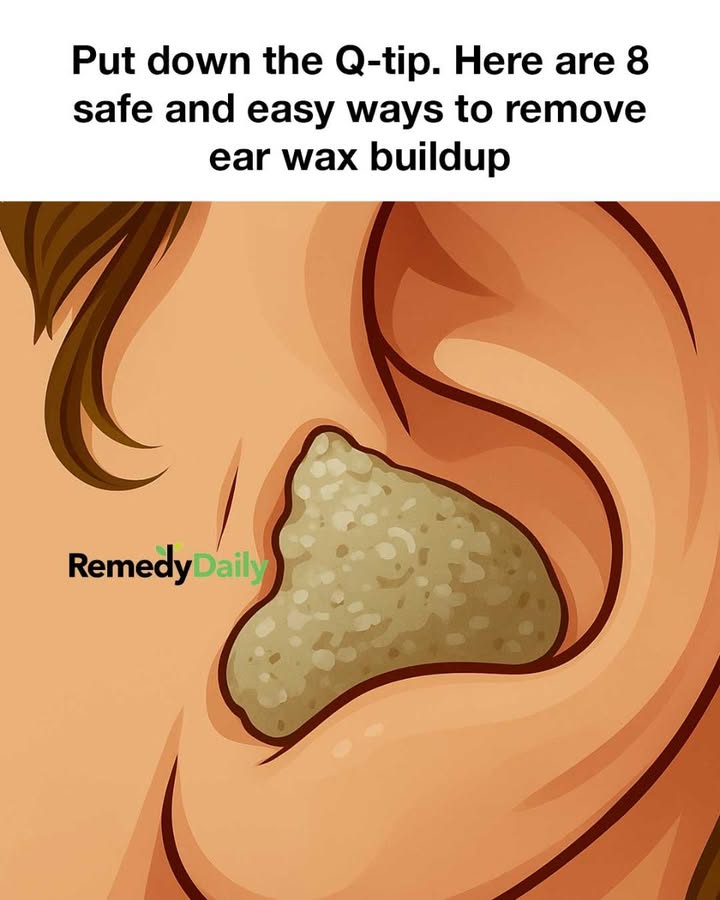Signs and Symptoms of Excessive Ear Wax Buildup

Put down the Q-tip. Here are 8 safe and easy ways to remove ear wax buildup
Excessive ear wax buildup can manifest in several ways. Common symptoms include a feeling of fullness or blockage in the ear, earache, tinnitus (ringing in the ears), and partial hearing loss. Some people may also experience dizziness or a persistent cough. If these symptoms occur, it may indicate that the ear wax has hardened and is obstructing the ear canal, necessitating removal.
When to Seek Professional Help for Ear Wax Removal
While home remedies can be effective, there are times when professional help is necessary. If you experience severe pain, persistent symptoms, or suspect an ear infection, consult a healthcare provider. Additionally, individuals with a history of ear surgery, perforated eardrums, or ear tubes should avoid self-treatment and seek medical advice. An audiologist or ENT specialist can safely remove ear wax using specialized tools and techniques.
1. Saline Solution: A Simple and Effective Remedy
Saline solution is a gentle and effective way to soften and remove ear wax. To use, mix a teaspoon of salt in half a cup of warm water until it dissolves. Using a dropper, place a few drops into the affected ear while tilting your head to the side. Allow the solution to sit for a few minutes to soften the wax, then tilt your head in the opposite direction to let it drain out. This method can be repeated daily until the wax is cleared.
2. Olive Oil: A Natural Lubricant for Easing Wax Removal
Olive oil is a natural remedy that can help soften ear wax, making it easier to remove. Warm a small amount of olive oil to body temperature and use a dropper to place a few drops into the ear. Lie on your side for about 5-10 minutes to allow the oil to penetrate the wax. This process can be done once or twice a day for a few days to facilitate wax removal.
3. Hydrogen Peroxide: Breaking Down Ear Wax Safely
Hydrogen peroxide is an effective agent for breaking down ear wax. Use a 3% hydrogen peroxide solution and apply a few drops into the ear with a dropper. You may hear a fizzing sound as the peroxide reacts with the wax. After a few minutes, tilt your head to let the solution and dissolved wax drain out. This method should be used with caution and not more than once a week to avoid irritation.
4. Baking Soda Solution: A Gentle Exfoliant for Ear Wax
Baking soda can be used to create a solution that helps dissolve ear wax. Mix a quarter teaspoon of baking soda in two ounces of water. Using a dropper, apply a few drops into the ear and let it sit for about 10 minutes. This solution can help break down the wax, making it easier to remove. Rinse the ear with warm water afterward to flush out the dissolved wax.
5. Warm Water Irrigation: Flushing Out Ear Wax Gently
Warm water irrigation is a simple method to flush out ear wax. Use a bulb syringe filled with warm water and gently squirt it into the ear canal while tilting your head to the side. The water should help dislodge and wash out the wax. Ensure the water is not too hot to avoid burns. This method is effective but should be done carefully to prevent damage to the ear.
6. Glycerin: Softening Ear Wax for Easy Removal
Glycerin is a safe and effective way to soften ear wax. It acts as a lubricant and helps break down hardened wax. Apply a few drops of glycerin into the ear using a dropper and let it sit for several minutes. This can be done up to three times a day for a few days to facilitate wax removal.
7. Vinegar and Alcohol Solution: A Balanced Approach
A mixture of vinegar and rubbing alcohol can help dissolve ear wax and prevent infections. Mix equal parts of white vinegar and rubbing alcohol. Use a dropper to place a few drops into the ear, allowing it to sit for a few minutes before draining. The vinegar helps dissolve the wax, while the alcohol dries the ear canal, preventing bacterial growth.
8. Over-the-Counter Ear Drops: Convenient and Reliable Options
There are various over-the-counter ear drops available that are specifically formulated to dissolve ear wax. These products often contain carbamide peroxide, which helps break down wax. Follow the instructions on the packaging for safe and effective use. These drops are convenient and can be a reliable option for managing ear wax buildup.
Precautions and Tips for Safe Ear Wax Removal at Home
When attempting to remove ear wax at home, it’s important to take precautions to avoid injury. Never insert sharp objects into the ear canal. Use remedies as directed and avoid excessive use to prevent irritation. If symptoms persist or worsen, seek professional medical advice. Regular ear hygiene, such as cleaning the outer ear with a damp cloth, can help prevent wax buildup.
Conclusion: Maintaining Ear Health and Hygiene
Maintaining ear health and hygiene is crucial for overall well-being. While ear wax serves protective functions, excessive buildup can cause discomfort and hearing issues. By using safe and effective methods for wax removal and seeking professional help when necessary, you can keep your ears healthy. Regular check-ups with a healthcare provider can also ensure any ear-related issues are addressed promptly.
